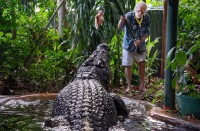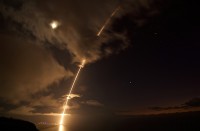Professional astronomers and amateur cosmologists flocked to a remote part of Western Australia Thursday to witness a total solar eclipse, with the moon blocking out the sun for 58 seconds.
Stargazers in Exmouth, on Australia’s northwest tip, parked their caravans, pitched telescopes and donned protective glasses to watch the moon seemingly creep across the sun’s surface before the totality.
“Many people become addicted to that minute or so of eerie otherworldliness” John Lattanzio of the Astronomical Society of Australia said.
“They become ‘eclipse chasers’ and they travel all over the world for repeat experiences.”
The totality occurred at 11:29:48 local time — bringing darkness and a spectral calm, according to witnesses.
Less than a minute later, the dusty outback was again bathed in light.
While fun and perhaps moving for spectators, the eclipse gave scientists a chance to observe the sun’s corona, which is usually obscured by its bright rays.
Witnessing a similar eclipse once helped Albert Einstein hypothesise that light can bend.
This time round residents in West Papua and East Timor will also be able to witness the totality.
A continent away in Sydney, the eclipse was only partial, with less than 20 percent of the sun blocked by the moon.
But the city’s residents can take some solace.
On July 22, 2028, its five million residents will experience their own total solar eclipse — one of five scheduled to occur over Australia in the next 15 years.
© Agence France-Presse







